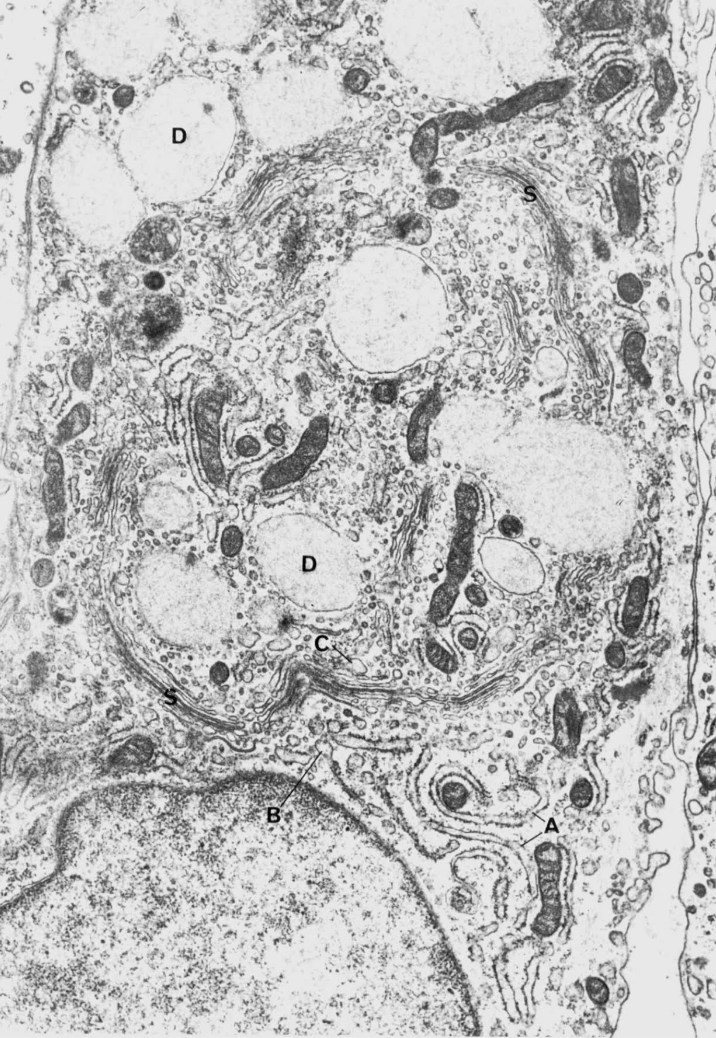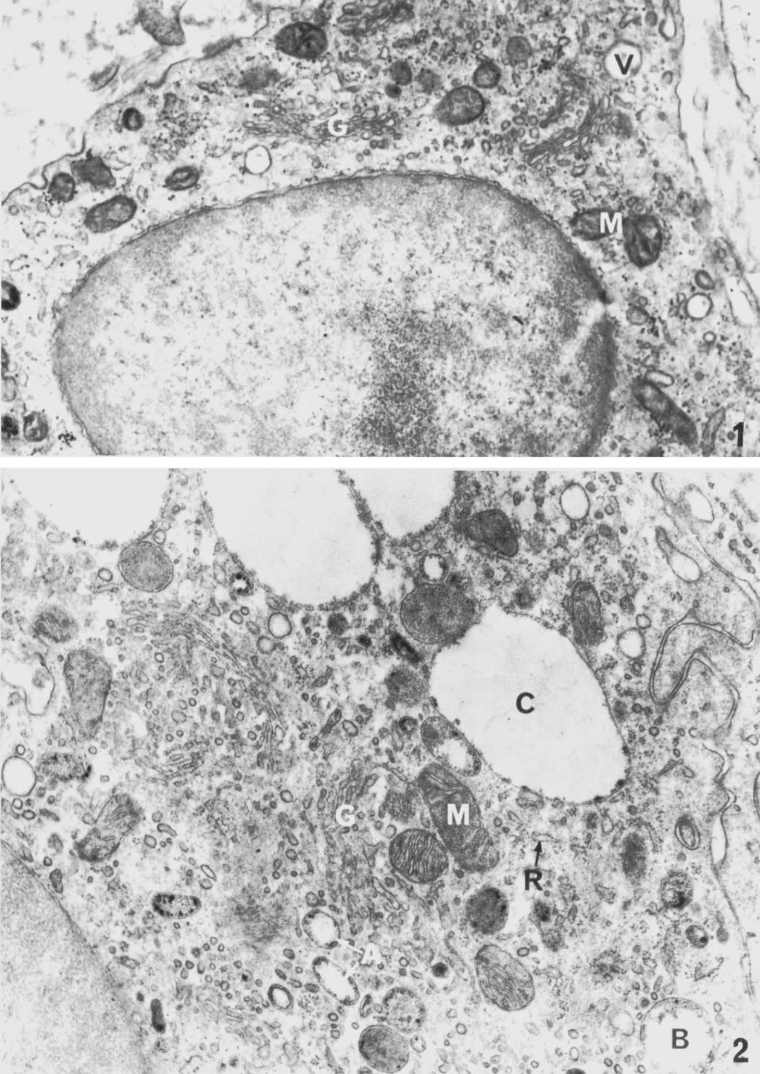高尔基体(Golgi Apparatus),又称高尔基复合体或高尔基体系,是细胞质内的一种细胞器。它的主要功能是加工、排序和运输细胞内的蛋白质和脂类分子。
书中详细描述了高尔基体的结构和功能。高尔基体由多个扁平的膜囊构成,这些膜囊形成了一个复杂的结构。高尔基体内部的空间被分成许多不同的间隙,这些间隙被称为高尔基间隙(Golgi cisternae)。高尔基突起(Golgi stack)是高尔基体中最明显的结构,通常排列成一列或一组。

Mucus-secreting cell from human bronchial mucosa, showing a large Golgi complex comprising stacks of flattened sacs (S) and numerous vacuoles and vesicles. Current concepts regarding the manner in which secretory granules containing mucin (a glycoprotein which with water forms mucus) are made is illustrated with the aid of this electron micrograph. The protein part of the glycoprotein is synthesized from the amino acids by the polyribosomes of the rough endoplasmic reticulum, and travel along its cisternae (A). Some sugars may be added to the protein at this stage. Intermediate or transport vesicles containing the newly synthesized material bud off (B) from the margins of the cisternae and coalesce with the saccules of the Golgi complex. The completion of synthesis is achieved in the Golgi complex by the addition of other sugars and the fully formed glycoprotein then emerges as single-membrane-bound granules (at times called droplets) by a process of budding from the Golgi stacks (C). In merocrine glands the secretory granules (D) then travel to the apex of the cell where the membrane bounding the granule fuses with the cell membrane prior to discharge of its contents. Thus at no stage is the cell cytoplasm exposed to the exterior during merocrine secretion. X 23 000
这是一张来自人类支气管黏膜的分泌粘液的细胞的电子显微镜图像,显示出一个大的高尔基复合体,包括许多扁平的囊泡(S)和许多空泡。利用这张电子显微镜照片,说明了关于粘液(一种由蛋白质和水形成的糖蛋白)的分泌颗粒是如何形成的现代概念。糖蛋白的蛋白质部分由粗面内质网的多肽核糖体从氨基酸合成,沿着其间隔膜(A)流动。此阶段可能会添加一些糖。包含新合成物质的中间或转运囊泡从间隔膜边缘(B)脱落,并与高尔基复合体的小囊融合。在高尔基复合体中通过添加其他糖完成合成,然后通过从高尔基堆中的分裂过程出现为单层膜结构的颗粒(有时称为小滴)(C)。在分泌型腺体中,分泌颗粒(D)然后运行到细胞的顶端,其中包围颗粒的膜与细胞膜融合,然后释放其内容物。因此,在分泌型腺体的分泌过程中,细胞质并没有接触到外部。图像放大了23,000倍。
高尔基体的功能非常多样化。由于这个细胞器在这些细胞中的显著性以及高尔基区域内存在分泌滴液,因此光学显微镜观察者长期以来一直怀疑其参与分泌过程。因此,基于这样的观察,Cajal在1914年已经设想在肠上皮中的杯状细胞中,粘液是在高尔基体内合成的。一些光学显微镜观察者非常清楚地看到了高尔基体参与分泌活动的作用,Bowen(1929年)的评论证明了这一点,他写道:“分泌本质上是一种“颗粒”或液滴的形成现象。

Fig. 1. Type A cell from human synovial membrane, showing Golgi stacks (G), vacuoles containing secretory material (V) and mitochondria (M). The scant rough endoplasmic reticulum and ribosomes lying free in the cytoplasm are barely discernible. X 25000 {From Ghadially and Roy, 1969) Fig. 2. Type A cell from rat synovial membrane, showing mitochondria (M) and sparse rough endoplasmic reticulum (R). A characteristic feature of the synovial cells of this species is the occurrence of numerous rather large secretory vacuoles which contain electron-lucent material surrounded by some medium-density material and a few electron-dense granules. A gradation in size of the vacuoles (A, B and C) is seen stemming from the Golgi region (G) to the cell surface which lay just beyond the top edge of the picture. X 26 000 (From Roy and Ghadially, 1967a)
图1:来自人类滑膜的A型细胞,显示高尔基体堆积(G)、包含分泌物的空泡(V)和线粒体(M)。细胞质中稀少的粗面内质网和游离的核糖体几乎难以分辨。X 25000(来源:Ghadially和Roy,1969)
图2:来自大鼠滑膜的A型细胞,显示线粒体(M)和稀疏的粗面内质网(R)。这种物种滑膜细胞的一个特征是出现许多相当大的分泌性空泡,其中包含电子透亮的物质,被一些中等密度物质和一些电子密度颗粒包围。从高尔基区域(G)到细胞表面(图片顶部的位置)可见大小渐变的空泡(A、B和C)。X 26000(来源:Roy和Ghadially,1967a)







